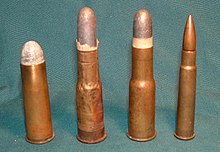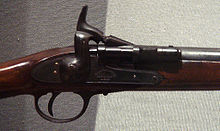Snider–Enfield
| Snider–Enfield | |
|---|---|
| Type | Service rifle |
| Place of origin | United Kingdom |
| Service history | |
| In service | 1867–1901 |
| Used by |
|
| Wars |
|
| Production history | |
| Designer | RSAF Enfield |
| Designed | 1860 |
| Manufacturer | RSAF Enfield |
| Produced | 1866–1880s |
No. built | ~870,000 |
| Variants | Long Rifle, Short Rifle, Engineer's Carbine, Cavalry Carbine, Artillery Carbine, Yeomanry Carbine, Naval Rifle, Royal Irish Constabulary Carbine |
| Specifications | |
| Mass | 8 lb 9 oz (3.8 kg) (unloaded) |
| Length | 49.25 in (1,250 mm) |
| Cartridge | .577 Snider |
| Calibre | 0.577 in (14.7 mm) |
| Action | Side-hinged breechblock |
| Rate of fire | 10 rounds/minute |
| Muzzle velocity | 1250 ft/s (original black powder load) |
| Effective firing range | 600 yd (550 m)[1][2] |
| Maximum firing range | 2,000 yd (1,800 m) |
| Feed system | Single shot |
| Sights | Sliding ramp rear sights, Fixed-post front sights |
The British .577 Snider–Enfield was a breech-loading rifle. The American Jacob Snider invented the firearm action, and the Snider–Enfield was one of the most widely used of the Snider varieties. The British Army adopted it in 1866 as a conversion system for its ubiquitous Pattern 1853 Enfield muzzle-loading rifles, and used it until 1874 when the Martini–Henry rifle began to supersede it. The British Indian Army used the Snider–Enfield until the end of the nineteenth century.
Contents
1 Design and manufacture
2 Service
3 Variants
4 Use today
5 See also
6 References
7 External links
Design and manufacture

(From Left to Right): A .577 Snider cartridge, a Zulu War–era rolled brass foil .577/450 Martini–Henry Cartridge, a later drawn brass .577/450 Martini–Henry cartridge, and a .303 British Mk VII SAA Ball cartridge.
In trials, the Snider Pattern 1853 conversions proved both more accurate than original Pattern 1853s and much faster firing; a trained soldier could fire ten aimed rounds per minute with the breech-loader, compared with only three rounds per minute with the muzzle-loading weapon. From 1866 onwards, the Enfield rifles were converted in large numbers at the Royal Small Arms Factory (RSAF) Enfield beginning with the initial pattern, the Mark I. The converted rifles received a new breechblock/receiver assembly, but retained the original iron barrel, furniture, lock, and hammer.
The Mark III rifles were newly made. They featured steel barrels which were so marked, flat nosed hammers, and a latch-locking breech block instead of the simple integral block lifting tang.
The Snider–Enfield used a new type of metal-cased cartridge called a Boxer cartridge after its designer. The breech block housed a diagonally downward sloping firing pin struck with a front-action lock mounted hammer. To operate the weapon, the rifleman cocked the hammer, flipped the block out of the receiver to the right by grasping the left mounted breech block lever, and then pulled the block back to extract the spent case. There was no ejector, so the firer lifted the case out or, more usually, turned the rifle upside-down to allow the case to drop out. (Perhaps even more usually, the firer then shook the weapon vigorously to dislodge hot cartridges or those fouled by dust or grime.)
Service

Snider breech-loading mechanism.
The Snider first saw action with the British/Indian Army at the battle of Magdala (Aroghee) in Ethiopia on 10 April 1868, against the forces of Tewodros II of Ethiopia; during the battle the 4th (King's Own) Regiment of Foot alone fired 10,200 rounds.[3] The Snider–Enfield served throughout the British Empire, including Cape Colony, India, Australia, New Zealand, and Canada, until its gradual phaseout by the Martini–Henry, beginning in 1874. Volunteer and militia forces continued to use it until the late 1880s. It stayed in service with the Indian Army until the mid-1890s, because between the Indian Rebellion of 1857 and 1905 the British kept the Indian Army one weapon generation behind British units. The Hunza Scouts may have been the last to use it in action (in the carbine version), in the Chitral campaign of 1895[4].The Indian units received the Martini–Henry when the British adopted the Lee–Metford. The Ijeshas used large numbers of Snider–Enfields against Ibadan during the 16-year-long Yoruba Civil War (1877 to 1893).
Frank Richards, who served on the Northwest Frontier between 1902 and 1908, records in Old Soldier Sahib that the British army still used Sniders during that period. Sentries on night duty in camps and cantonments would carry a Snider and buckshot cartridges. Should tribesmen try to get into the camp to steal rifles, the buckshot would give the sentries a better chance of hitting the thief, and unlike a .303 round, would be less likely to wound or kill a comrade should the sentry miss.
The Snider was notably powerful. Rudyard Kipling gave a graphic depiction of its effect in his poem, "The Grave of the Hundred Head":
A Snider squibbed in the jungle—
Somebody laughed and fled,
And the men of the First Shikaris
Picked up their Subaltern dead,
With a big blue mark in his forehead
And the back blown out of his head.
Variants

A Snider rifle used in Japan during the Boshin war (1868–69).
The Snider–Enfield was produced in several variants. The most commonly encountered variants were the Rifled Musket or Long Rifle, the Short Rifle, and the Cavalry and Artillery Carbines. The Long Rifle has a 36.5 inches (93 cm) barrel and three barrel bands. Its total length (without bayonet) is 54.25 inches (137.8 cm) in length, longer than most rifles of the time. It was issued to line infantry and has three-groove rifling with one turn in 78 inches (200 cm). The Short Rifle has a 30.5 inches (77 cm) barrel and two barrel bands with iron furniture. This variant was issued to sergeants of line infantry and rifle units. It has five-groove rifling with one turn in 48 inches (120 cm). The Cavalry Carbine is half stocked and has only one barrel band. It has a 19.5 inches (50 cm) barrel, with the same rifling as the Short Rifle. The Artillery Carbine has a 21.25 inches (54.0 cm) barrel with a full stock and two barrel bands, and the same rifling as the Short Rifle and Cavalry Carbine.
The Snider was the subject of substantial imitation, in both approved and questionable forms, including the Nepalese Snider, which was a nearly exact copy, the Dutch Snider, Danish Naval Snider, and the "unauthorised" adaptations of the French Tabatière and Russian Krnka.
There were also "Trade Pattern" Snider–Enfields, being Snider–Enfields made for private purchase by various English gun-makers. These were often intended for sale to members of volunteer military units, or simply to anyone who might wish to purchase a rifle.
Use today
Enthusiasts still use these rifles today, with the number in circulation boosted by the acquisition by Atlanta Cutlery and International Military Antiques of a vast quantity of antique weapons held in the Royal Nepalese Armory in the Lagan Silekhana Palace for over a century. Ammunition is reloaded into either modern production .577 Snider cases, or reformed 24 gauge brass shotgun shells. Black powder or modern black powder substitutes are used. The HCRA in Halifax does live fire demonstrations daily in the Halifax Citadel, fire blanks many times a day, while they are also in possession of around 60 of these rifles. In addition, the FHG at Fort Henry also uses the various variants of this weapon for their reenactments.
[5]
See also
- British military rifles
- Trapdoor Springfield
References
^ The Army quarterly and defence journal Vol 104. West of England Press. 1973. p. 91....Snider-Enfield, which had an effective range of 600 yd.
.mw-parser-output cite.citation{font-style:inherit}.mw-parser-output .citation q{quotes:"""""""'""'"}.mw-parser-output .citation .cs1-lock-free a{background:url("//upload.wikimedia.org/wikipedia/commons/thumb/6/65/Lock-green.svg/9px-Lock-green.svg.png")no-repeat;background-position:right .1em center}.mw-parser-output .citation .cs1-lock-limited a,.mw-parser-output .citation .cs1-lock-registration a{background:url("//upload.wikimedia.org/wikipedia/commons/thumb/d/d6/Lock-gray-alt-2.svg/9px-Lock-gray-alt-2.svg.png")no-repeat;background-position:right .1em center}.mw-parser-output .citation .cs1-lock-subscription a{background:url("//upload.wikimedia.org/wikipedia/commons/thumb/a/aa/Lock-red-alt-2.svg/9px-Lock-red-alt-2.svg.png")no-repeat;background-position:right .1em center}.mw-parser-output .cs1-subscription,.mw-parser-output .cs1-registration{color:#555}.mw-parser-output .cs1-subscription span,.mw-parser-output .cs1-registration span{border-bottom:1px dotted;cursor:help}.mw-parser-output .cs1-ws-icon a{background:url("//upload.wikimedia.org/wikipedia/commons/thumb/4/4c/Wikisource-logo.svg/12px-Wikisource-logo.svg.png")no-repeat;background-position:right .1em center}.mw-parser-output code.cs1-code{color:inherit;background:inherit;border:inherit;padding:inherit}.mw-parser-output .cs1-hidden-error{display:none;font-size:100%}.mw-parser-output .cs1-visible-error{font-size:100%}.mw-parser-output .cs1-maint{display:none;color:#33aa33;margin-left:0.3em}.mw-parser-output .cs1-subscription,.mw-parser-output .cs1-registration,.mw-parser-output .cs1-format{font-size:95%}.mw-parser-output .cs1-kern-left,.mw-parser-output .cs1-kern-wl-left{padding-left:0.2em}.mw-parser-output .cs1-kern-right,.mw-parser-output .cs1-kern-wl-right{padding-right:0.2em}
^ Macdonald, John Hay Athole (1909). Fifty years of it: the experiences and struggles of a volunteer of 1859. W. Blackwood and Sons. p. 232.The Snider-Enfield even at 600 yards, which was the limit of the really effective range of the rifle for accurate shooting.
^ Markham, Clements R (1869) A History of the Abyssinian Expedition (Macmillan & Co); p. 325.
^ Beynon, L. (1895) With Kelly To Chitral
^ Holt Bodinson (March 2006), "Britain's big .577 Snider", Guns Magazine
External links
| Wikimedia Commons has media related to Snider-Enfield rifle. |
- Video of shooting Snider–Enfield M1866 artillery carbine
- Loading and Firing a Snider–Enfield